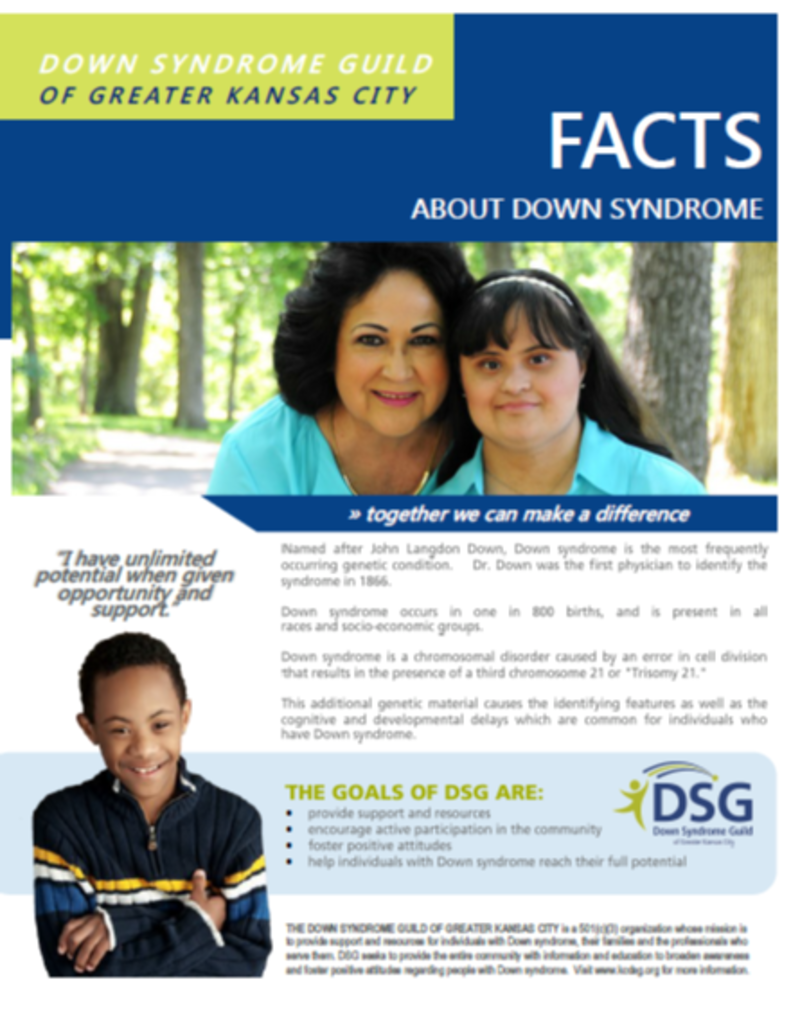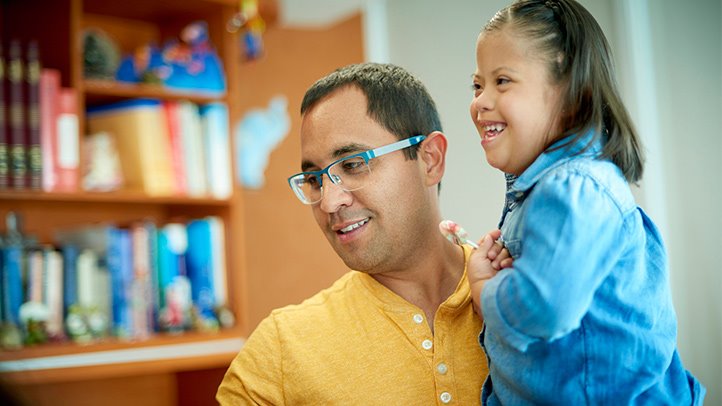About Down syndrome
Down disorder (DS), additionally called Trisomy 21, is a condition wherein an individual is brought into the world with an additional chromosome. Chromosomes contain hundreds, or even thousands, of qualities. Qualities convey the data that decides your attributes (highlights or attributes gave to you from your folks). With Down disorder, the additional chromosome causes delays in the manner in which a youngster grows, intellectually and genuinely.

The physical highlights and medicinal issues
related with down disorder can shift generally from kid to youngster. While a
few children with DS need a great deal of restorative consideration, others
have solid existences.
Despite the fact that down disorder
can’t be forestalled, it tends to be distinguished before a kid is conceived.
The medical issues that may oblige DS can be dealt with, and numerous assets
are accessible to help kids and their families who are living with the
condition.
What It Causes?
Typically, at the hour of origination
an infant acquires hereditary data from its folks as 46 chromosomes: 23 from
the mother and 23 from the dad. By and large of down disorder, a kid gets an
additional chromosome 21 — for an aggregate of 47 chromosomes rather than 46.
It’s this extra hereditary material that causes the physical highlights and
formative postponements related with DS.
Albeit nobody knows without a doubt
why DS occurs and it is extremely unlikely to forestall the chromosomal blunder
that causes it, researchers do realize that ladies age 35 and more seasoned
have a fundamentally higher danger of having a kid with the condition. At age
30, for instance, a lady has around a 1 out of 1,000 possibility of imagining a
youngster with DS. Those chances increment to around 1 of every 400 by age 35.
By 40 the hazard ascends to around 1 out of 100.
How Down syndrome affects Kids
Children with down disorder will in
general offer certain physical highlights, for example, a level facial profile,
an upward inclination to the eyes, little ears, and a jutting tongue.
Low muscle tone (called hypertonia) is additionally normal for kids with DS, and infants specifically may appear to be particularly “floppy.” Though this can and regularly improves after some time, most youngsters with DS commonly arrive at formative achievements — like sitting up, creeping, and strolling — later than different children.

During childbirth, kids with DS are
for the most part of normal size, however they will in general develop at a
slower rate and stay littler than their friends. For newborn children, low
muscle tone may add to sucking and nourishing issues, just as obstruction and
other stomach related problems. Babies and more seasoned children may have
delays in discourse and self-care aptitudes like bolstering, dressing, and
latrine instructing.
Down disorder influences children’s
capacity to learn in various manners, yet most have mellow to direct scholarly
debilitation. Children with DS can and do learn, and are fit for creating
aptitudes for the duration of their lives. They basically arrive at objectives
at an alternate pace — which is the reason it’s significant not to contrast a
kid and DS against normally creating kin or much other kids with the condition.
Children with DS have a wide scope of
capacities, and it is highly unlikely to tell during childbirth what they will
be equipped for as they grow up.
Therapeutic Problems Associated With DS
While a few children with DS have no
huge medical issues, others may encounter a large group of therapeutic issues
that require additional consideration. For instance, practically 50% of all
youngsters brought into the world with DS will have an inborn heart deformity.
Children with down disorder are
additionally at an expanded danger of creating pneumonic hypertension, a
genuine condition that can prompt irreversible harm to the lungs. All newborn
children with down disorder ought to be assessed by a pediatric cardiologist.
Roughly 50% of all children with DS
likewise have issues with hearing and vision. Hearing misfortune can be
identified with liquid development in the inward ear or to basic issues of the
ear itself. Vision issues normally incorporate strabismus (cross-looked at),
close or farsightedness, and an expanded danger of waterfalls.
Customary assessments by an
otolaryngologist (ear, nose, and throat specialist), audiologist, and an
ophthalmologist are important to distinguish and address any issues before they
influence language and learning aptitudes.
Other ailments that may happen all the
more every now and again in kids with DS incorporate thyroid issues, stomach
and intestinal issues, seizure issue, breathing issues, including rest apnea
and asthma, heftiness, an expanded possibility of contaminations, and a higher danger
of youth leukemia. Individuals with down disorder now and then have an insecure
upper spine and ought to be assessed by a specialist before taking an interest
in physical exercises. Luckily, a large number of these conditions are
treatable.
Pre-birth Screening and Diagnosis
Two sorts of pre-birth tests are
utilized to identify down disorder in a hatchling: screening tests and
demonstrative tests. Screening tests gauge the hazard that an embryo has DS;
indicative tests can tell whether the hatchling really has the condition.
Screening tests are practical and
simple to perform. But since they can’t offer a conclusive response with
respect to whether a child has DS, these tests are utilized to assist guardians
with concluding whether to have progressively symptomatic tests.
Indicative tests are about 99% exact
in identifying down disorder and other chromosomal variations from the norm. Be
that as it may, in light of the fact that they’re performed inside the uterus,
they are related with a danger of unnatural birth cycle and different
complexities.
Therefore, intrusive indicative testing
recently was commonly suggested distinctly for ladies age 35 or more seasoned,
those with a family ancestry of hereditary deformities, or those who’ve had an
anomalous outcome on a screening test.
In any case, the American College of
Obstetrics and Gynecology (ACOG) presently suggests that every single pregnant
lady be offered screening with the choice for intrusive demonstrative testing
for Down disorder, paying little mind to age.
In case you’re uncertain about which
test, assuming any, is directly for you, your primary care physician or a
hereditary guide can assist you with figuring out the advantages and
disadvantages of each.
Screening tests include:
Nuchal translucency testing. This
test, performed somewhere in the range of 11 and 14 weeks of pregnancy,
utilizes ultrasound to quantify the away from in the folds of tissue behind a
building up child’s neck. (Infants with DS and other chromosomal anomalies will
in general amass liquid there, causing the space to seem bigger.) This
estimation, taken together with the mother’s age and the child’s gestational
age, can be utilized to figure the chances that the infant has DS. Nuchal
translucency testing is typically performed alongside a maternal blood test.
The triple screen or fourfold screen
(additionally called the various marker test). These tests measure the amounts
of ordinary substances in the mother’s blood. As the names infer, triple screen
tests for three markers; the fourfold screen incorporates one extra marker and
is increasingly exact. These tests are regularly offered somewhere in the range
of 15 and 18 weeks of pregnancy.
Coordinated screen. This uses results
from first-trimester screening tests (with or without nuchal translucency) and
blood tests with a subsequent trimester fourfold screen to think of the most
precise screening results.
A hereditary ultrasound. A point by
point ultrasound is regularly performed at 18 to 20 weeks related to the blood
tests, and it checks the baby for a portion of the physical attributes
variations from the norm related with Down disorder.
Cell free DNA. This test breaks down
fetal DNA found in the mother’s blood. It very well may be done in the first
trimester and is more precise at distinguishing Trisomy 21 than standard blood
tests. Presently cell free DNA testing is just offered to ladies at high danger
of having an infant with Down Syndrome.
Demonstrative tests include:
Chorionic villus testing (CVS). CVS
includes taking a little example of the placenta, either through the cervix or
through a needle embedded in the stomach area. The benefit of this test is that
it tends to be performed during the primary trimester, normally somewhere in
the range of 10 and 12 weeks. The hindrance is that it conveys a somewhat more
serious danger of unnatural birth cycle as contrasted and amniocentesis and has
different confusions.
Amniocentesis. This test, performed
somewhere in the range of 15 and 20 weeks of pregnancy, includes the evacuation
of a limited quantity of amniotic liquid through a needle embedded in the
stomach area. The cells would then be able to be examined for the nearness of
chromosomal variations from the norm. Amniocentesis conveys a little danger of
inconveniences, for example, preterm work and unnatural birth cycle.
Percutaneous umbilical blood testing
(PUBS) or cordocentesis. Normally performed following 18 weeks, this test
utilizes a needle to recover a little example of blood from the umbilical line.
It conveys dangers like those related with amniocentesis.
After an infant is conceived, if the
specialist speculates DS dependent on the newborn child’s physical qualities, a
karyotype — a blood or tissue test recolored to show chromosomes gathered by
size, number, and shape — should be possible to confirm the determination.
Assets That Can Help
In case you’re the parent of a
youngster determined to have down disorder, you may from the outset feel
overpowered by sentiments of misfortune, blame, and dread. Conversing with different
guardians of children with DS may assist you with managing the underlying stun
and misery and discover approaches to look toward what’s to come. Numerous
guardians find that learning as much as they can about DS helps facilitate a
portion of their feelings of dread.
Specialists suggest selecting kids
with down disorder in early-intercession benefits at the earliest opportunity.
Physical, word related, and language instructors and early-youth teachers can
work with your kid to support and quicken advancement.
Numerous states give free
early-mediation administrations to kids with incapacities from birth to age 3,
so check with your primary care physician or a social specialist to realize
what assets are accessible in your general vicinity.
When your youngster is 3 years of age,
the person is ensured instructive administrations under the Individuals with
Disabilities Education Act (IDEA). Under IDEA, nearby school areas must give
“a free proper instruction at all prohibitive condition” and an
individualized training program (IEP) for every kid.
Where to send your kid to class can be
a troublesome choice. A few children with Down disorder have needs that are
best met in a specific program, while numerous others do well going to
neighborhood schools close by peers who don’t have DS. Studies have indicated
that this sort of circumstance, known as incorporation, is gainful for both the
youngster with DS just as different children.
Your school locale’s youngster study
group can work with you to figure out what’s best for your kid, however
recollect, any choices can and ought to include your contribution, as you are
your kid’s best backer.
Today, numerous children
with down disorder go to class and appreciate huge numbers of indistinguishable
exercises from different children their age. A couple go on to school. Many
progress to semi-free living. Still others keep on living at home however can
hold employments, in this manner finding their own achievement in the network.